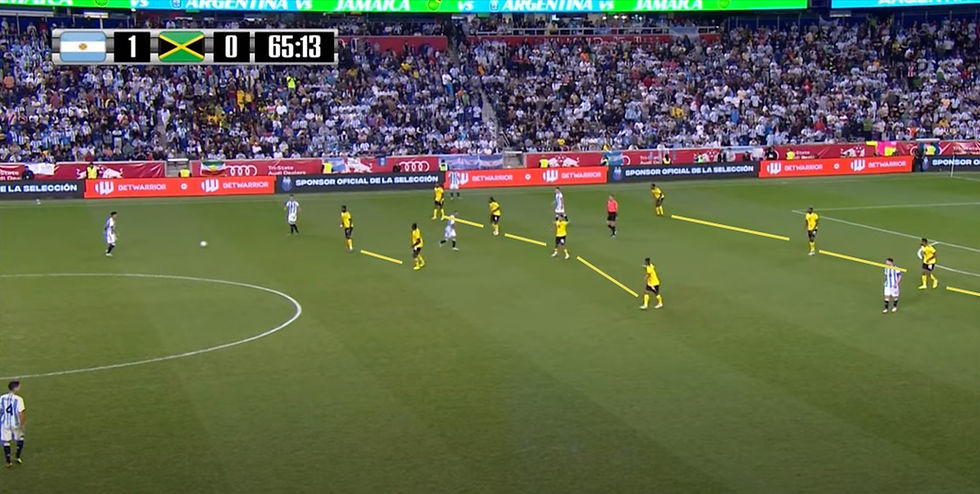World Cup Tactical Trends: 2018 Russia
- All Angles Football -
- Jul 31, 2020
- 5 min read
This post is the third and final post of the World Cup tactical trends series. Two previous posts explored tactical trends from the 2010 and 2014 World Cups. This post will briefly explore tactical trends from the 2018 World Cup which include:
Compact defending, counter attacks and the redundancy of ball possession
The importance of set pieces
Free 8s
As mentioned in the last post exploring the 2014 World Cup tactical trends, counter attacking emerged across Europe as a more popular tactic in an effort to stifle teams that would want to dominate possession throughout the game. This continued to become more and more popular and was the same tactic that champions France used throughout the tournament. Additionally, although not a mainstream tactic throughout the 2018 World Cup, it is important to highlight the Free 8 role that emerged from Pep Guardiola’s Manchester City, which was replicated by England coach Gareth Southgate.
Compact Defending and Counter Attacks
Continuing from the 2014 World Cup, counter attacking continued to emerge as a popular and effective tactic across Europe. Many teams sat in low compact blocks absorbing pressure, closing spaces and passing lanes while conceding possession waiting to win the ball and quickly transition to attack as the opposition would be vulnerable, often leaving much space open behind them as they commit many players forward to attack. Whereas most counter-attacking teams used three in the back at the 2014 World Cup, this was not necessarily the case at the 2018 World Cup as the formations were more diverse including Iceland’s 4-4-2, France’s 4-2-3-1 and Iran’s 4-1-4-1. This proved to be a very effective tactic for the teams that used it considering the following:
France mainly counter attacked and won the tournament. They ranked 19th out of 32 for ball possession, which displays that a majority of possession is not important.
Spain had the most ball possession on average (69%) and were knocked out at the Round of 16 by Russia who sat in a low compact block for 120 minutes before going to penalties
Iran almost knocked Portugal out in their final group game which was tied 1-1, with Portugal under much pressure through the game from Iran
Mexico beat Germany 1-0 in a shocking defeat with the sole goal coming from a counter attack, South Korea also scored two goals on a counter attack to knock out Germany although South Korea did not make it through the group
Belgium beat Japan 3-2 in the Round of 16, with their winning goal being scored on a counter attack in the last minute of the game. Belgium also knocked out Brazil in the quarter finals 2-1 with one goal from a set piece (which will be discussed next) and the other goal off a counter attack
A more detailed explanation of the counter attacking tactic can be seen on the 2014 World Cup tactical trends post. The clip below shows what compact defending is including closing spaces, blocking lines and conceding possession.
The three clips below show counter attacks and how dangerous they can be due to spaces left open by the attacking team. It is very important to transition rapidly from the defensive to the attacking phase and move the ball forward quickly with intent for the counter attack to be a counter attack and one that is effective.
Set Pieces
One of the main highlights from this World Cup was the importance of set pieces. From free kicks, corners, penalties and throw ins, many teams created and had many goal scoring opportunities. As many teams decided to sit back and defend in a low block, conceding possession, set pieces were a dangerous opportunity to score goals from. This is especially true considering the introduction of VAR which saw more fouls called and penalties awarded during this World Cup than before. As set pieces are dead ball situations and can be strategically planned (therefore hard to defend against), this gives teams opportunities to score against teams that are stronger than them and/or also gives teams the opportunity to break a close tie (which France did in the 1-0 semi-final against Belgium).
One in every 29 corners led to a goal at the 2018 World Cup, which was 1 in 61 in 2010 and 1 in 36 in 2014. Fifteen of the 32 teams at the tournament scored at least half of their goals from set pieces, which clearly displays how important they were and can be for teams. England are the best example of this, creating the most opportunities using set pieces (22) throughout the tournament. They made it to the semi-finals scoring nine goals from set pieces which is a tournament record. The clips below show set pieces used through the tournament from both France and England.
Free 8s
Although this is not a widespread trend from the World Cup itself. The role of the “free 8" was displayed in England’s tactics at the tournament and were influenced by Pep Guardiola’s utilization of David Silva and Kevin De Bruyne at Manchester City. Pep decided to play Silva and De Bruyne (two natural No. 10s) in the two No. 8 central midfield roles in a 4-3-3. Allowing both players to utilize their creativity and giving them freedom to find spaces, drift wide or inside into spaces and to also push forward into/around the box to create chances. They were also tasked with doing more defensive work than usual, even though this may not be clear at first glance. Gareth Southgate replicated this with Jesse Lignard and Dele Alli in England’s 3-5-2. Jordan Henderson anchored the midfield while Lingard and Alli essentially played a role similar to De Bruyne’s and Silva’s at Manchester City. They were given the freedom to roam around when England had the ball and to find spaces to create opportunities and play much closer to Harry Kane and Raheem Sterling. However, while England were in the defensive phase, the two had to sit back closer to Jordan Henderson and put in a defensive shift. This can be seen in the average positions map for England throughout the tournament below. Alli and Lingard are both circled in the defensive and offensive phase of play.

It is also worth giving a quick mention to playing out the back as a tactical trend that has become widely popular across Europe and was also replicated by England at the World Cup. This was done especially through John Stones, one of many center backs today who are very good on the ball and have extraordinary passing abilities. It is a tactic used by many teams including Manchester City and Arsenal where these teams attempt to start building up play and creating chances through their defenders and the use of ball playing center backs such as John Stones and David Luiz are vital to this. It is also important to have a goalkeeper who is good with the ball at his feet (mentioned in the 2014 World Cup tactics article) to help build up play from the back. This is why Pep Guardiola decided to drop Joe Hart when arriving at Manchester City and opt for Claudio Bravo and then Ederson. The clip below shows what it looks like as Manchester City play out the back.
Again it can be seen that tactics continue to evolve around Europe and the world in general and these are replicated on the world stage at the World Cup every four years. Some trends are replicated and displayed more than others as can be seen with the counter attacks and set pieces whereas the "free 8" was not as widely replicated at the World Cup. However, fans can continue to anticipate changes and innovations in tactics and their popularity ahead of the 2022 World Cup where it is likely to see something new.




Comments